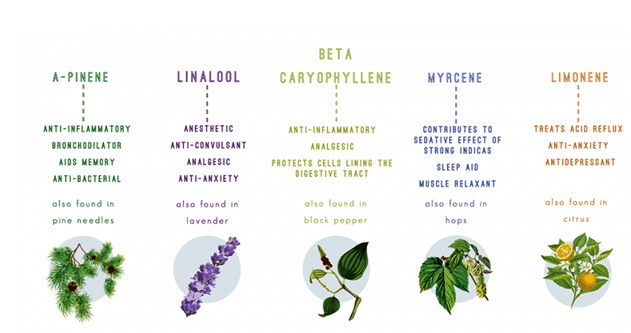Legalized cannabis continues to conquer larger and larger portions of the national gross domestic product as more people discover it’s therapeutic benefits.Many cannabis products out there use terpenes, the natural flavoring chemicals natively found in Cannabis sativa in vivo, to replicate the unique flavor and psychosomatic profile of individual cannabis varieties.
Terpenes (or ‘terps’) are small, volatile chemical agents used by the cannabis plant for a multitude of reasons. These include being chemical precursors for more complicated molecules and providing pheromone-like activity towards pollinators. Terpenes are what gives many plants, and chemovars of cannabis, their individual aromatic profiles that we find so pleasing.
Figure 1. The major terpene constituents in Cannabis sativa (1).
When it comes to extracting terpenes for industrial use in the cannabis industry, companies can choose from using cannabis-derived or hemp-derived terpenes. Hemp is a variety of Cannabis sativa, often grown specifically for fiber or other industrial uses, although medicinal products containing CBD extracted from hemp have become more pervasive and are even marketed on Amazon. Hemp is known for the remarkable tensile strength of its fibers but possesses significantly lower quantities of cannabinoids and terpenes than cannabis.
So, why would companies choose to extract terpenes from hemp? Well, hemp is legal to grow in most states in the US, even those that have not yet legalized adult-use or medicinal cannabis. Since terpenes are not restricted by the federal government, a hemp grow and extraction process operation can be set up basically anywhere in the country.
Figure 2. CBD-Only laws in general refer to hemp-growing operations, since it contains only trace amounts of THC but a larger quantity of CBD (2).
However, there are a few reasons why getting terpenes from hemp is undesirable. For one, hemp is genetically incapable of supporting levels of terpenes as high as cannabis can (3). This means that a significantly larger quantity of hemp feedstock is required to obtain a given mass of extracted terpenes relative to cannabis, raising the cost of production.
Another reason is that using larger amounts of hemp for the same product effectively transforms hemp into a bio-accumulator. Large fish in our seas, rivers, and oceans, are positioned at the top of the food chain in their respective environments. Plankton at the bottom of the food chain absorbs mercury and other heavy metals from the environment. Because each successive species in the chain consumes a large volume of food each day to stay alive, the fish at the top accumulates hazardous amounts of toxins in its meat.
This analogy is true for extracting terpenes from hemp also.Large volumes of hemp are required to purify a given quantity of terpenes, meaning that the end product can contain a significantly larger amount of toxins from the soil in which the plants are grown. This is not desirable in consumable products, and adds additional purification strains to the manufacturing process.
Figure 3. Plankton and bacteria may each only ingest miniscule amounts of mercury, but since mercury cannot be eliminated from the host once ingested, each successive step up the food chain accumulates more (4).
Hemp contains lower levels of terpenes, so more biomass will be required to produce the desired quantities of terpenes. The use of more plant material, however, can ultimately affect the taste of the final product, as molecules like chlorophyll have been shown to be detrimental to taste. Hemp, in general, has an earthier and grassier scent to it that tends to be very difficult to purify out of end-products.
Although research is still being done in this area, cannabis is no doubt a better source for terpenes than hemp. It requires less starting material, produces higher-quality terpenes, and sidesteps the toxicity issues associated with hemp extractions. However, in states where cannabis is illegal but agricultural soil is fertile and land and labor is cheap, hemp extracting operations are a viable option. We hope that soon cannabis will be legal throughout the United States, and these dilemmas can be avoided entirely.
References
- https://www.alchimiaweb.com/blogen/marijuana-terpenes-effects
- https://azmarijuana.com/dans-stash/map-states-with-pro-marijuana-laws
- Andre et al. Cannabis sativa: The Plant of the Thousand and One Molecules. Frontiers in Plant Science. 2016;7:19. doi:10.3389/fpls.2016.00019.
- https://www.whalefish.org/single-post/2014/04/29/Bioaccumulation-and-Biomagnification-in-the-marine-environment














